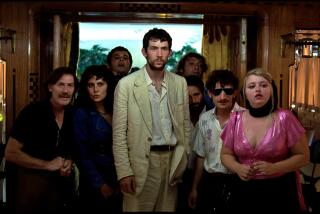A Second Look: ‘In the City of Sylvia’
“In the City of Sylvia,” a 2007 film by the Spanish writer and director José Luis Guerín, runs a mere 80 minutes and has almost no dialogue and the barest semblance of a plot. But from seemingly minimal means, Guerín fashions a gorgeous object and an endlessly suggestive experience: a love story, a city symphony, a surrealist fable and a self-reflexive meditation on the thrill and the danger of looking.
A cult hit on the festival circuit — new to DVD May 24 from Cinema Guild — “Sylvia” follows the romantic quest of an unnamed young man over three days in the French city of Strasbourg. It opens with the delicately scruffy protagonist (Xavier Lafitte) lost in thought in his hotel room, scribbling and sketching in his notebook. He takes to the picturesque streets, gazing at the many lovely women around him, apparently searching for one in particular.
In the first of several tour de force sequences, Guerín plants his hero amid a sea of partly obscured faces and partly overheard conversations at an outdoor cafe, creating a wealth of feelings and moods from the tiniest gestures and from small, precise shifts in camera perspectives and focal lengths.
About half an hour into the film, the young man sets his sights on one especially striking beauty (Pilar López de Ayala) who he thinks — or hopes? — is his long-lost Sylvia. He sets off on a more or less real-time pursuit, following her through busy squares and winding cobblestone streets, in and out of shops, and finally onto a tram, where he musters the nerve to ask if she is indeed the girl he met at a bar in that city six years ago.
Is his beloved Sylvia a memory, a ghost or a delusion? By the end of the movie, Sylvia is both everywhere and nowhere — she comes to stand for all the women in the city but is also an ideal that doesn’t exist.
This most open-ended of reveries is rife with filmic citations, not least Alfred Hitchcock’s “Vertigo,” perhaps the ultimate tale of erotic obsession and the vortexlike pull of an absent love. The tram ride nods to a famous one in F.W. Murnau’s silent classic “Sunrise.”
The structure, with chapter divisions that break the film into successive nights (even though it mostly takes place during the day), point to another influence: Robert Bresson’s “Four Nights of a Dreamer.” Meanwhile, the hints of role play and false memory call to mind Alain Resnais’ “Last Year at Marienbad” and Abbas Kiarostami’s recent “Certified Copy.”
Without belaboring them, Guerin also makes room for various literary allusions, from Goethe, who studied in Strasbourg and wrote about obsessive love in “The Sorrows of Young Werther,” to the surrealist Andre Breton, whose novel “Nadja” is a dreamlike account of being haunted by a woman and a city.
Redolent as it is with sly, high-toned references, the film also has a pronounced documentary aspect. Guerin, whose other works could be classified as personal or experimental nonfiction, embeds this abstract story in the real fabric of a city, which doesn’t just look but also sounds very much alive. Dialogue is minimal, but sounds are all-important in the tapestry of footsteps, voices, traffic, church bells and ambient urban noise.
The Cinema Guild disc also includes “Some Photos in the City of Sylvia,” a silent, black-and-white companion film that functions as a kind of sketch for “In the City of Sylvia.” Using both moving and still images, it retraces the steps of Guerin’s own brief encounter in Strasbourg some 20 years ago.
Guerin refers to the male protagonist of “In the City of Sylvia” as “the dreamer,” but he is also arguably a voyeur and a stalker. The film, which occasionally takes on a hint of creepiness, could be deemed an exercise in what feminist theorists call the “male gaze.”
But more than a movie about a man watching women, “Sylvia” conjures a state of mind, a way of looking at people and things. In other words, it’s about new faces and new places, the imagined stories that run through our heads about them, the chance encounters and missed opportunities that are part of daily existence.
Consecrated to the pleasures and the possibilities of the incidental, “In the City of Sylvia” is also a testament to the power of cinema to capture the evanescent.
More to Read
The biggest entertainment stories
Get our big stories about Hollywood, film, television, music, arts, culture and more right in your inbox as soon as they publish.
You may occasionally receive promotional content from the Los Angeles Times.






